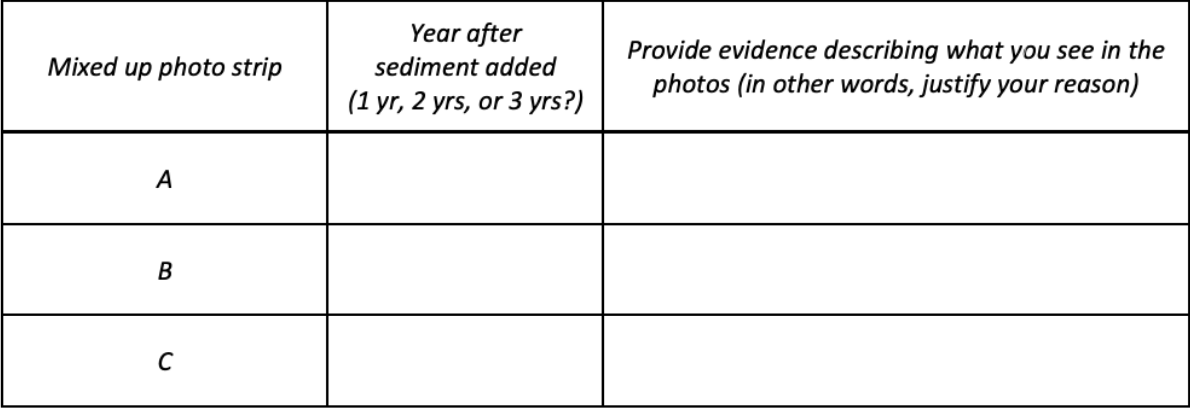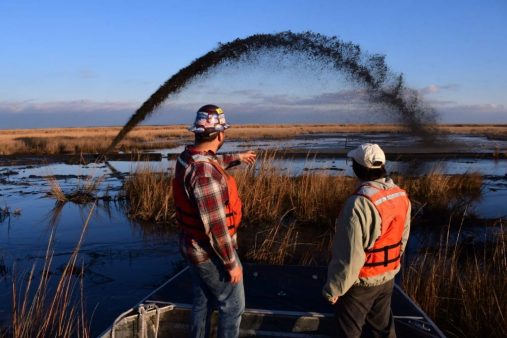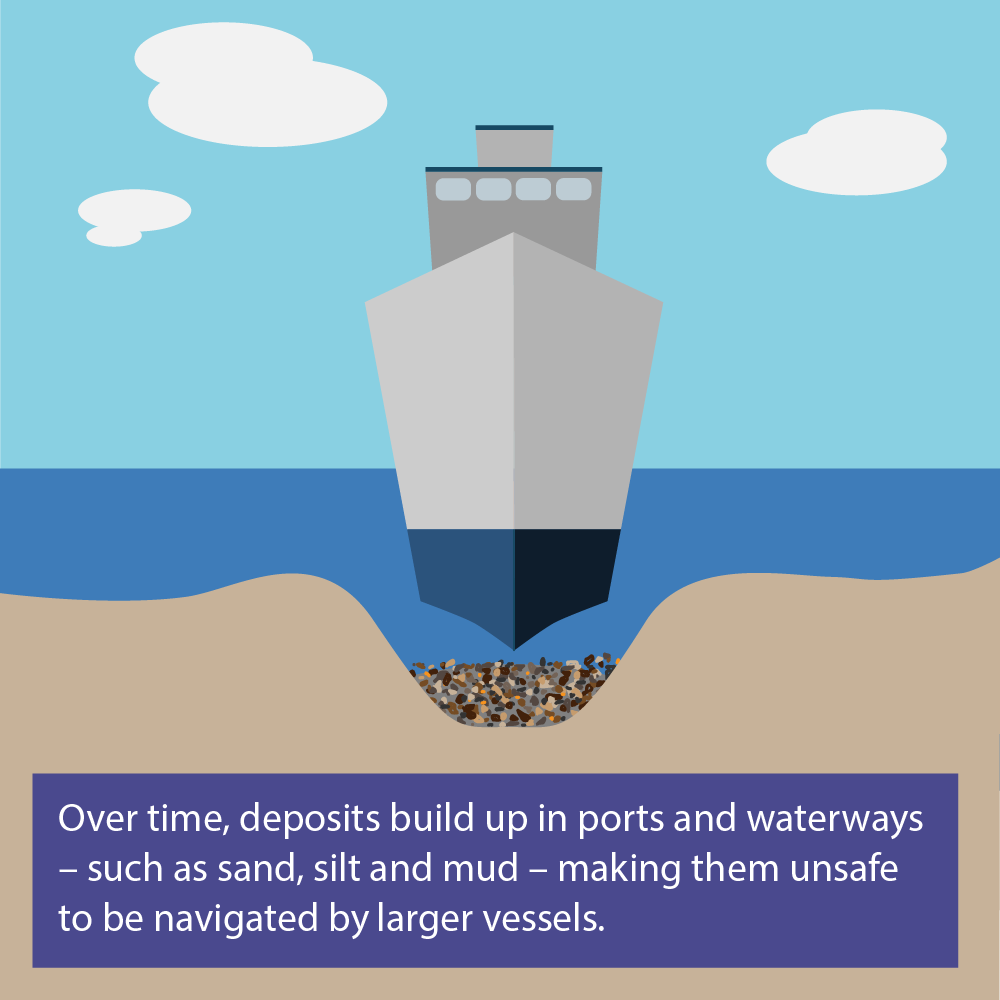Data Mystery: Sinking Marsh
The case of the sinking salt marsh: What can we do to help restore our submerging marshes?
Let's Get Started!
Kate bikes down to their favorite Long Island Sound salt marsh where they have been monitoring salt marsh sparrows the last few years and is surprised and confused to see a huge arch of muck being sprayed onto the marsh. “What’s going on?! There are rare birds that nest in that marsh! And what’s that smell?!” shouts Kate at the harbor manager and the work people wearing orange work vests.
The harbor manager explains why the harbor needs dredging, and how the dredged sediment can be beneficially reused to help replace eroded coastlines or placed on submerging salt marshes.
They use the images below and the video to help explain the dredging process and potential uses of the dredged sediment.
TO-DO
Write down two questions Kate might ask the harbor manager after checking out the photos and video above and seeing what is happening at their favorite salt marsh. Write them down on your activity sheet.
Kate keeps thinking about those salt marsh sparrow nests they have been tracking over the past few years. They head over to the marsh to speak with Chris, the salt marsh manager, to ask what’s going to happen to that area covered in dredged sediment when the salt marsh sparrows return in the spring to make nests and lay eggs.
Chris explains, “Managers want to restore drowning salt marshes that are rapidly submerging due to accelerated sea level rise. One emerging approach that we are just starting to use in the northeastern US is to add sediment to marshes to increase the elevation and reduce flooding.” Chris asks Kate, “If you were a coastal manager, what are some factors you would consider when using dredged material for salt marsh restoration?”
Chris says “I have a friend named Madeline who’s in graduate school studying marshes in Connecticut. She set up an experiment to examine how different sediment depths affect salt marsh vegetation regrowth for a few years after adding the sediment. She compared a no-addition “Control” treatment, to different depths of added sediment (“Low”: +5 cm, “Medium”: +10 cm, “High”: +15 cm). She shared some photos of the first three years with me, but unfortunately, the pictures got out of order. Can you help me sort this out?”



TO-DO
Write what year (1-3) after the sediment was added you think aligns with the mixed up photo strips (A-B) in the table on your activity sheet and why.

Chris calls Madeline to check their work and let them know that the photos are back in order. What surprises you the most about these photos? Write your answer on your activity sheet.
Madeline explains “Over time the plants in the high treatment really fill in. It takes time for salt marsh grasses that grow vegetatively (via underground stems) to respond to changes in their environment. In addition to looking at change over time with photos, we measure plant biomass. I’ve been monitoring these plots for four years. What do you think will happen in year 5 and 6?” Look at Figure 1 below and complete the following with your group.

Figure 1
a) UConn scientists measured how different sediment depths (Control, Low, Medium, High) added to a submerging marsh in Guilford, Connecticut affected aboveground plant biomass over four years. Their experiment had six replicates per treatment. The points represent the average aboveground biomass and the vertical lines represent the variability among the six replicates (standard error).
b) Draw your hypothesized data points for Y5 and Y6 on your activity sheet.
TO-DO
Answer the following questions on your activity sheet:
1) Does adding sediment increase aboveground biomass relative to the controls?
2) Which treatment depth seems to promote plant biomass most in Year 2?
3) What about in Year 4?
4) What do you think will happen in Years 5 and 6?
5) Extend the lines for the four treatments into Years 5 and 6 on the figure (disregard error bars).
Kate starts thinking about other variables that affect how adding sediment impacts marsh restoration. They ask “There was a strong rotten egg smell this morning when I was watching them spray the dredge sediment. What was that from?” Madeline responds “That rotten egg smell indicates the presence of sulfides, which form in the absence of oxygen. Sulfides can be toxic to plants and when exposed to oxygen in the air can form sulfuric acid.” Kate asks “Is it a good idea to add sediment with a lot of stinky sulfides to a drowning marsh?”
Madeline says “Great question! It may not be a good idea to use those stinky sediments because it has the potential to form acid sulfate soils. Soils should be tested before they are added to drowning marshes. I’m actually testing out a variety of materials that can be added to potential acid sulfate soils to reduce their acidity.” Madeline even made a video to help explain her work.
TO-DO
After watching the video, write down one question your group still has for the scientist.
Kate isn’t convinced that you can neutralize an acid with a base and wants to try it for themself. Their teacher helps out by providing some materials and space for an experiment you can do in your classroom, too!
Let’s try this with an acid and a base in our classroom. Vinegar is an acid (acetic acid) and shells are basic and made of calcium carbonate. Before you begin, work with your group to propose a hypothesis. How will adding shells to vinegar affect the pH of the solution? Which do you think will change the pH of vinegar more - whole or crushed shells?
TO-DO
As a group, fill in the blanks on your activity sheet: Our group thinks that adding shells to vinegar will ___________ the pH of the solution. If we place ______________________in vinegar it will change the pH of the liquid the most.
Write two reasons on your activity sheets as to why you’ve made this claim.
- ________________________________________________________________________________________________________________________________________
- ________________________________________________________________________________________________________________________________________
Time to test your guess with an experiment
Wearing safety goggles, set up 3 beakers marked as follows:
- Vinegar
- Vinegar + 2 Crushed Shells
- Vinegar + 2 Whole Shells
Create a data table on your activity sheet to record your data. Test the pH of the solution immediately after you set up the experiment, and then periodically over the course of the week and record your data.
TO-DO
After all data has been collected, write what you discovered on your activity sheet.
Now it’s your turn to design a salt marsh restoration!
Sediment is actually being added to salt marshes in the northeastern U.S. now, but restoration recommendations may vary depending on different environmental conditions, location of the marsh relative to coastal communities, whether it’s in a commonly used recreational area (e.g., state park), and desired outcomes.
Look up the coordinates on Google maps of two potential salt marshes where remediation is being considered and create an action plan that you, as the manager might consider.
1
Marsh A. Bride Brook (41.304483859962744, -72.24245094890676)
- Very wet site with lots of standing water that doesn’t drain at low tide, not a lot of vegetation
- In a very popular state park for beach visitors

Marsh A. Bride Brook (41.304483859962744, -72.24245094890676)
- Very wet site with lots of standing water that doesn’t drain at low tide, not a lot of vegetation
- In a very popular state park for beach visitors
Marsh B. Sluice Creek (41.27343973728168, -72.66171358699285)
- No obvious water ponding, lots of vegetation cover though it may be stressed and shorter than typical salt marsh vegetation.
- Near a popular town boat launch with lots of recreational walkers and bird watchers
2
Marsh B. Sluice Creek (41.27343973728168, -72.66171358699285)
- No obvious water ponding, lots of vegetation cover though it may be stressed and shorter than typical salt marsh vegetation.
- Near a popular town boat launch with lots of recreational walkers and bird watchers

Managers need to make lots of decisions before adding sediment to a drowning marsh. Some actions managers may choose to take during the restoration process are listed below, but if you think of others, add them to the list.
Select any of the following actions to use in each photo and provide evidence from this activity’s lessons and background knowledge to support the actions you’ve chosen for each site.
Restoration Actions:
- Add a thin layer of sediment
- Add a thick layer of sediment
- Plant marsh grasses
- Amend sediment with crushed shells or concrete
- Test dredged soil before putting it on marsh
- Ask community members what they think
- Include erosion control structures
- Provide educational materials for the public explaining the process
- Nothing - use this area as a test area
- Collaborate with scientists and citizen scientists to monitor any action taken so we can learn
- Control invasive species (prevent “weed” species from taking over until native plants thrive)
TO-DO
On your activity sheet, write down your proposed actions and why you selected each.
Our proposed actions for Site A are to_____________ because______________.
Our proposed actions for Site B are to_____________ because______________.


